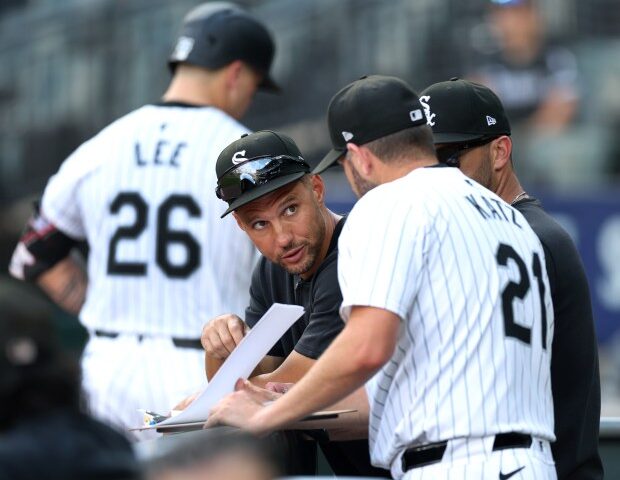Green Bay Packers coach Matt LaFleur crystallized what the NFL is and how the league is designed when asked about his team’s 11-game winning streak against the Chicago Bears, the longest in the storied history of the rivalry.
“Most teams in this league, it’s a .500 league,” LaFleur said. “You have to find a way to win some of these tight games like we did.”
LaFleur is right. The NFL is designed to create parity. There’s a gravitational pull that brings the majority of the league — half the teams most seasons anyway — within a game or two of .500. Good teams, the ones that are well-coached and the ones that manage to remain healthy find ways to pull ahead of the pack. The bad rosters, the teams that are poorly coached and the ones that get beat up with injuries are stragglers.
The Bears fell to 4-6 after losing to the Packers 20-19 on Sunday at Soldier Field when Cairo Santos’ 46-yard field goal was blocked by Karl Brooks on the final play. The Bears have lost four games in a row and the shame of it — the disgrace — is that twice in those four weeks they’ve lost on the final play when they should have won. This could be a 6-4 team. But they’re not.
Here are 10 thoughts following the latest gut-wrenching defeat.
1. Imagine what the national narrative would be for Caleb Williams if the Bears had not lost on a Hail Mary at Washington and if Cairo Santos’ field goal had sailed through the uprights in the south end zone Sunday.
The Bears would be 6-4. They would be in the NFC playoff picture. And Williams would have a reputation for delivering in the closing minutes of the fourth quarter, a big-time performer when the game is on the line.
For the second time in four weeks, Williams did his part when it mattered most. He didn’t play a perfect game but coming off of consecutive lousy performances by the offense and the firing of offensive coordinator Shane Waldron, Williams looked the part of the No. 1 draft pick again.
The Bears were super-efficient on third down — converting 9 of 16 (56.3%) — and it was just the ninth time since the start of the 2016 season they’ve been above 55%. They were 3 of 3 on fourth down. They didn’t turn the ball over. They had 391 yards on offense — the third-highest total of the season. They had a good mix of run and pass and they operated crisply.
When things looked bleak, like you’d be able to heap blame at the end of the game on the offensive line, Williams delivered.
Trailing 20-19, the Bears took over on their own 30-yard line with 2:59 remaining and one timeout, an eternity of time to get in position for their reliable kicker Cairo Santos. The Packers, who had just one sack to that point, got a sack from defensive tackle T.J. Slaton on first down and then defensive end Rashan Gary bull-rushed left tackle Braxton Jones straight back into Williams on second down, leaving the Bears with third-and-19.
The reality was the offensive line, with Jake Curhan having to replace Ryan Bates (concussion) in the first quarter, did a pretty solid job. Kenny Clark, the Packers’ three-time Pro Bowl defensive tackle, was a nonfactor. Clark didn’t show up in the box score — no tackles, no assists, no quarterback hits, nothing. He’s been a one-man wrecking crew in previous meetings.
Williams responded, sneaking out of the pocket to his right on third down and connecting with Rome Odunze for a 16-yard gain. On fourth-and-three, with the game on the line, Williams cooly lobbed a back-shoulder fade along the sideline for Odunze, who hauled it in with cornerback Keisean Nixon in close man coverage. Big moment. Bigger throw.
“Pocket started squeezing down a little bit on the first one,” Williams said. “When it comes to two-minute and things like that, it’s find your one-on-ones and find your guys. When it’s time to make plays, make plays. Obviously still have the routine plays, but at that moment, it was time to make plays. We did a good job with finding Rome and Rome finding space and sitting right there making sure I saw him. Just let it rip and let him make plays.
“Then on the fade ball, just good call by (offensive coordinator Thomas Brown). I think they would be expecting a run or getting something there at the sticks. This is a matchup league. To be able to have my guy Rome one-on-one with somebody, won off the line, kind of knowing that the (defensive backs) are in catch-up mode, give him a back shoulder ball, he’s either going to get a (pass interference call) or he’s going to catch it. He did just that, made the catch — great catch, unbelievable catch — and got us going.”
Williams made a nice throw on an out route to Keenan Allen on the next play and just like that the Bears were at the Green Bay 30-yard line, within the range of Santos, who had connected from 53 yards to the north end zone earlier in the game.
Williams finished 23 of 31 for 231 yards and ran nine times for a season-high 70 yards with five carries resulting in first downs. He was more decisive as a thrower and runner. When it wasn’t there, he was pulling the ball down and he was gone. The Bears mixed in the quarterback run game and while they were not super explosive plays, they got positive yards and helped stay ahead of the chains.
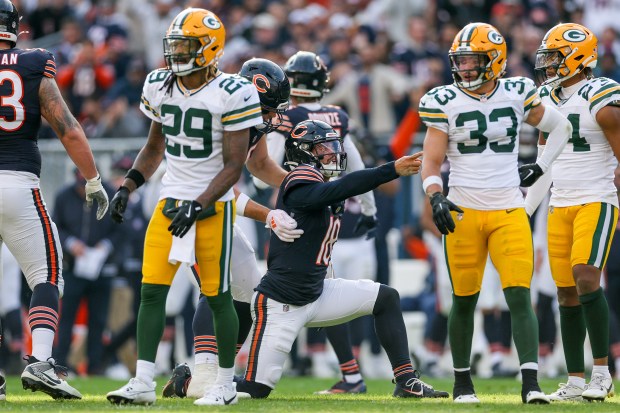
Coach Matt Eberflus talked about how the Bears played complementary football. While you cannot get carried away trying to take positives out of yet another loss, this season — above everything else — is about the performance of Williams and it’s been a roller coaster to this point with a coordinator fired midway through.
“He doesn’t have to be the No. 1 overall pick all the time,” tight end Cole Kmet said. “And I think when the moment calls for it and we need that, at the end of the game, you know you take two sacks to start the drive, OK, now the No. 1 pick has to come out. That came out.
“That showed itself so that was really cool to see. But I thought throughout the rest of the game, this was the cleanest he’s been in the huddle with the operation, got us into good looks here and there. He just did a good job of operating the offense and then at the end of the game being Caleb Williams was cool to see.”
Through 10 games, Williams has experienced a lot and if he can build off the positives at the same rate he’s learning from mistakes, the next seven games will be interesting even if the Bears are chasing in the playoff picture.
“You keep going,” he said. “That’s my mindset for just about anything. (USC coach) Lincoln Riley called me the other day and just wanted to talk to me, check in. It’s something that he told me my freshman year (at Oklahoma) when I wasn’t in a position I wanted to be in, which was I wasn’t starting at the time. He told me to keep going.
“At that time, I didn’t necessarily know what those two words meant. I wanted to hear a little bit more than that, and that’s what he told me. I use those words to this day. That’s when I got the starting point, kept working, kept going. That’s all I can do. That’s all we can do is keep going, keep our head down and find ways to win. We’re going to keep doing that.”
Had the Bears found a way to win here — and found a way to close out the game against the Commanders — the Williams narrative would be significantly different. If nothing else, in the noise surrounding Halas Hall, we will not be hearing about speculative quarterback changes.
2. The most noticeable changes with Thomas Brown taking over as offensive coordinator: The Bears got out of the huddle more efficiently and used more reduced formations.
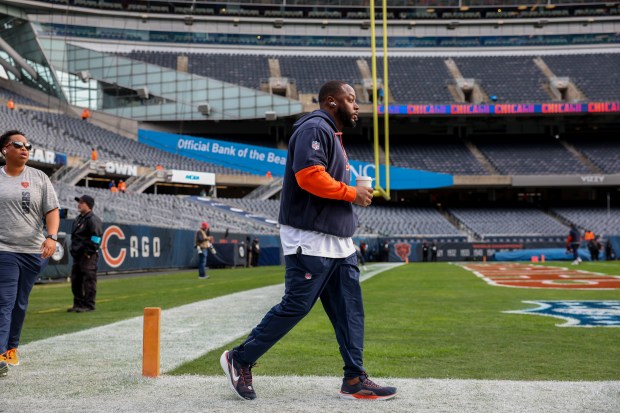
But there were some other subtle changes.
Remember, one game and the 68 offensive plays are a small sample size and good coordinators are constantly evolving and mixing up how they attack opponents. Good defensive coaches can begin to form a book on play callers after two, maybe three games, so Brown will have to be spry as a tactician in how he schemes things up weekly.
“Caleb (Williams) was getting the call pretty quickly after the previous play,” Cole Kmet said. “We were in the huddle, moving. Really didn’t have too many times where the (play) clock was running down. Think we had one. That’s much better than it has been.”
The Bears struggled mightily to establish any rhythm under Shane Waldron. They had too many instances where they got to the line of scrimmage late. But the bigger issue was play selection. Multiple scouts who have studied the Bears this season said it was really difficult to determine the direction on a weekly basis. Who are they trying to attack? What matchups do they want to exploit? How are they building off plays run earlier in the game? That stuff shows up in film review and it’s usually pretty easy to decipher. It was a jumbled “who knows?” when it came to the Bears.
The Bears ran more reduced or tight formations inside the numbers to create angles and edges or leverage. That was plain as day on the pin-and-pull from a trips formation in which D’Andre Swift got outside and raced 39 yards for a touchdown with left tackle Braxton Jones flattening safety Evan Williams in space to spring the running back.
Brown said everything starts up front and he stayed true to that as the Bears finished with 34 rushes (five were scrambles by Williams) and 31 pass attempts (there were also three sacks). Roschon Johnson was a bigger part of the plan getting a season-high 10 carries and one reception. Johnson can run inside and help set the tone and get the offensive line moving forward.
I wonder if Brown wants to limit Williams’ passing volume if the game situation allows. It makes sense with the Bears playing better this season when they’ve got more balance. They can manage games like this. It appears they are going to have more college spread elements in there. Brown wants Williams to carry the ball as a runner a little bit and Waldron did here and there. There were a lot of quick throws in the passing game where Williams has to see it and throw it. Why? That protects him and it protects the personnel because they have struggled so much up front.
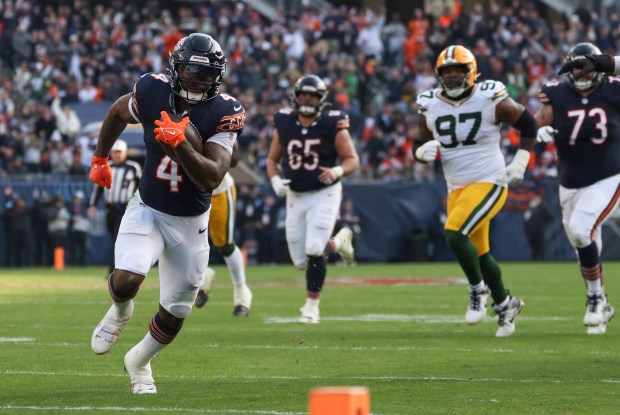
One of the best throws of the game was a deep shot to Kmet for 25 yards, a ball that was perfectly threaded between decent coverage. It was one of the few downfield throws. Again, we’re looking at a small sample size here but with Brown calling plays, are the Bears going to throw deep less often?
Williams has struggled this season with throws downfield and there were a lot under Waldron. It doesn’t mean they didn’t scheme shot plays against Green Bay. Maybe they were not there. Maybe he pulled the ball down to run in an instance or two where there was a vertical shot possibility. But under Waldron, he was throwing downfield quite a bit and wasn’t successful. Those are plays that take longer to develop and when the offensive line is struggling unless you max protect, maybe they’ve limited some of what they want to do here.
We’ve only got clues to work with in terms of how the offense will evolve with Brown at the controls, but there were some improvements and despite what Kmet labeled a “devastating” loss, at least the players were able to leave the locker room feeling like they are headed in the right direction. That matters when it comes to walking into a meeting room on Monday morning and out to the practice field on Wednesday.
“Belief,” Johnson said when asked what his takeaway was. “We believe in each other. Caleb really isn’t the question. It’s just been an excuse. We’re showing ourselves that we can do it. We executed in (the late game) situation. That’s a positive for sure.
“We haven’t been put in a lot of situations like that. I think seeing we can do it definitely does something mentally to players that gives them confidence when they get in that situation the next time.”
3. The ball sat in Karl Brooks’ stall as he packed his bag in the Packers locker room. It was the one he deflected with his left hand, blocking Cairo Santos’ 46-yard field goal attempt on the game’s final play.
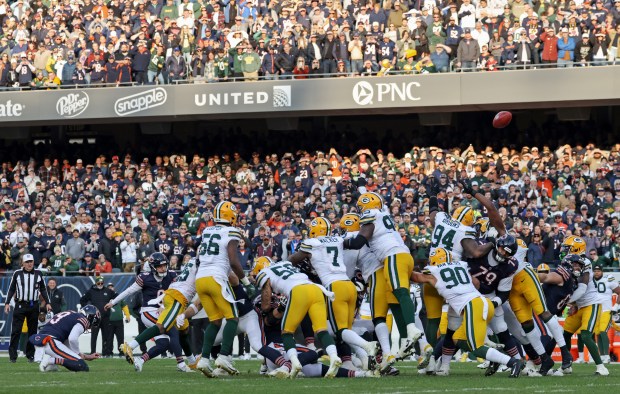
“That (stuff) is cool,” said Brooks, a sixth-round draft pick out of Bowling Green last year. “I like it.”
Brooks had an inkling he was going to make a play with the game on the line. I’ve yet to talk to a player who blocked a kick that didn’t sense he was going to make a play but Packers special teams coordinator Rich Bisaccia, the guy Matt Eberflus initially hoped to hire (they had worked together previously in Dallas), laid out the plan during the week.
“Rich said to our team (Saturday) night, I will not understand if we come out of this game without a block, whether field goal or PAT,” coach Matt LaFleur said.
The Packers sent Brooks and Lukas Van Ness, the first-round draft pick in 2023 from Iowa and Barrington High School, through the A gap between guard Matt Pryor and long snapper Scott Daly.
“All week we felt like they had some weaknesses in their A gaps,” Van Ness said. “Their kicker kind of had some low balls from a little bit of a further distance. A lot of what we worked on was that A-gap pressure and it happens to work out that’s where the block was. It goes to show you a lot of that stuff we watch on film sometimes comes to life on game day.
“Karl and I knew we were going to be in there and we lined up side by side and we had a feeling … when I felt him go down and kind of get a little push there, I just got behind him and pushed as hard as I could. I heard the block. I looked around. I didn’t know who blocked it. I had a huge mass of humanity in front of me but all I know is I saw everybody run on the field and that’s a great feeling.”
Brooks, who blocked a kick against Minnesota last season, said he jumped when he felt he was close enough and shot up his left arm.
“I was like, ‘Man, I’m going to block this,’” said Brooks, who the Bears brought to Halas Hall on a top-30 visit last year. “I got a hand on it.”
Column: The cruelty of the Chicago Bears’ losing skid is reaching new levels. Make it make sense.
It was crushing to the Bears, who have supreme confidence in Santos and were comfortable with that range as they let the clock wind down to three seconds before calling timeout.
“Left hash in that left-to-right wind, everything felt great and it looked like the line that the ball was going was right down the middle,” Santos said. “I hit it solid on my foot. Operation was good, snap, hold. They just made a good play with the penetration there.”
Matt Eberflus was asked about trying to run another play or two to make it a shorter try for Santos. It’s a reasonable question. Last week, the Kansas City Chiefs defeated the Denver Broncos when they blocked a 35-yard field goal on the game’s final play.
“They were loading the box there,” Eberflus said. “You could say you could do that for sure, maybe get a couple more yards, but you’re also going to risk fumbling and different things there. We felt where we were, if we’re at the 36 or 35, you definitely want to do that because you want to get it inside there. I felt very confident where we were at that time with the wind and where we were on the field.”
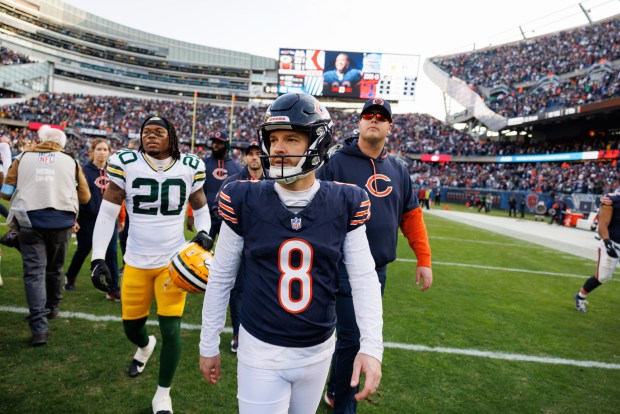
The Bears have been losing so much that when they choose one strategy and it doesn’t work, Eberflus will be slammed. That’s the way it goes. Let’s say they run another play and Roschon Johnson picks up 3 or 4 yards, I don’t think that’s going to make much difference in the trajectory of the kick. Santos had one kick blocked earlier this season in London but that came on a high snap by emergency long snapper Cole Kmet.
The Bears opted to kick there and Eberflus would have been crushed even harder had he called a run and a Packers defender got a helmet on the ball and popped it out for a fumble. Eberflus has made a lot of tactical mistakes. If he calls a play there, I think he looks for a high-percentage pass knowing the Packers were defending the run. There are things that can go wrong there too.
As it turned out, the protection wasn’t good. Brooks made a hell of a play and the kick was a little lower because of the distance. Whatever can go wrong seemingly does. It’s a shame because Santos reached 1,000 points in his career in the game with seven points — two field goals and an extra point.
“They just made one more play than we did,” Daly said. “Everybody saves their best for last. They were able to make one more play than we did. Tough way to end especially the way the offense moved the ball. They had a great drive for us.”
Otherwise, the ball that Brooks stuffed in a bag before heading to the bus is one Santos would have taken home with him.
4. The call was brassy, for sure.
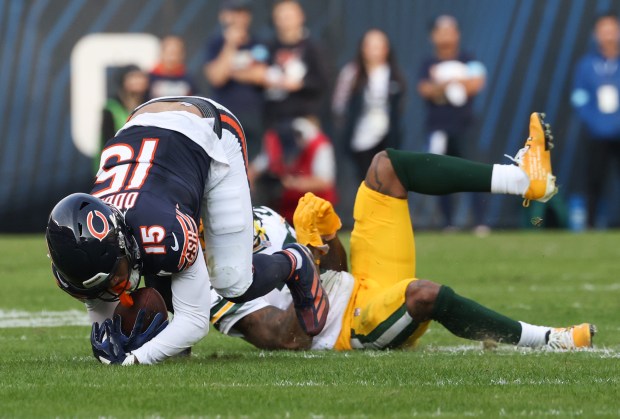
Trailing by a point and facing fourth-and-3 from their own 37-yard line, most of the 59,419 in attendance at Soldier Field were probably expecting some kind of short route. The Bears went up top for Rome Odunze.
That one play is a sign that justifies the decision to select the wide receiver with the ninth pick in the draft and I write that with a full understanding of the current and future issues the team is facing on the offensive line.
It was the perfect play call for Odunze with his frame — 6-foot-3, 215 pounds — and he made the back shoulder fade for 21 yards against cornerback Keisean Nixon look easy.
“I always think the ball is coming my way until it doesn’t,” Odunze said when I asked him if he was surprised Thomas Brown didn’t dial up a higher-percentage call. “I don’t care if it’s a run play, I might be getting the ball. Every single time I am running to get the ball. That’s my attitude every play.”
Odunze had done a nice job on the third-and-19 play on the previous snap, recognizing Caleb Williams was fleeing the pocket and sitting down in a void in the zone coverage to present the quarterback with a clear target.
“We always keep our heads up and maintain the attitude that we’re going to go get it done and that’s what we did,” Odunze said. “We were able to get a good gain on third down and then make a play on that fourth (down) and just continuing to drive by any means necessary. That’s our attitude and we were able to execute.”
Odunze was targeted a team-high 10 times (one off his season-high) and made six catches for 65 yards. He’s had two 100-yard games and has 34 receptions (second on the team) for 479 yards (leads the team) putting him on pace for 58 and 814.
While the connections have been frayed at times this season, I think it’s fair to say Williams and Odunze are forming the kind of chemistry that can be valuable later this season and into the future. Odunze also hasn’t shown frustration and the Bears were just as high on his character as they were his ability.
So, while there is a lot of work to be done on the offensive line and the Bears are going to have to hit on their moves there, not just make moves, Odunze profiles as a potential difference-maker.
You can tell Brown has a ton of faith in Odunze with the call on a play that could have defined the game.
5. One reason the Bears had success on third down is because six of their 16 plays were in third-and-1 or third-and-2.

They stayed ahead of the chains for most of the game because they ran the ball effectively to get balance.
The 179 yards rushing was the second-highest total of the season. While the Bears cannot count on Caleb Williams to run for 70 yards every week, there was a commitment, success and the Bears showed a willingness to utilize Roschon Johnson more in the base package to balance the workload with D’Andre Swift.
That’s important to note here because Swift has 155 carries for the season, putting him on pace for 264. That would be 35 more than the career-high 229 he had last season in Philadelphia. Swift’s best skills are in the open field and he’s not the kind of back an offense wants to pound 20-plus carries week after week, so a subtle move to get Johnson more involved is probably two-fold. Thomas Brown wants to lean into Johnson’s strengths and he wants to keep Swift fresh and effective throughout the second half of the season.
“It felt like a turning point during the week for us,” Cole Kmet said. “I felt really good about the plan coming in. Credit to (Brown) getting things together, asking a little bit more of everybody this week and I thought that showed out on the field today.
“Sure, there are a lot of things we can still get better at. I thought his commitment to the run game was awesome to see and he’s using his Caleb and his legs and then be able to do some play-action stuff downfield, all really good stuff.”
An emphasis on the running game will take some pressure off the offensive line that has been under siege, and when you can do it and stay within proper down and distance it keeps the playbook wide open.
“Ran the ball well which opened up everything,” center Coleman Shelton said. “I think it started with that and Caleb did a fantastic job the whole game. (Third down success) came because we were third and manageable, third-and-2, third-and-short, so run calls were in play. We could run, pass, anything and defense had to cover it all. It was just we were staying on track and on rhythm.
“It felt like there was a groove to the game. We were able to kind of do what we wanted to do against the different looks we were hoping to get. It was a good rhythm game and it’s 100% something to build off of, growing into it as the season goes along.”
It’s going to be tough sledding this coming week. The Minnesota Vikings have one of the best run defenses in the league, allowing only an average of 74.4 yards per game and 3.6 per carry. But the Bears will have to find a way to strike a balance to keep the blitz-heavy attack off Williams.
6. The switch to Thomas Brown as offensive coordinator this past week seemingly energized the locker room.
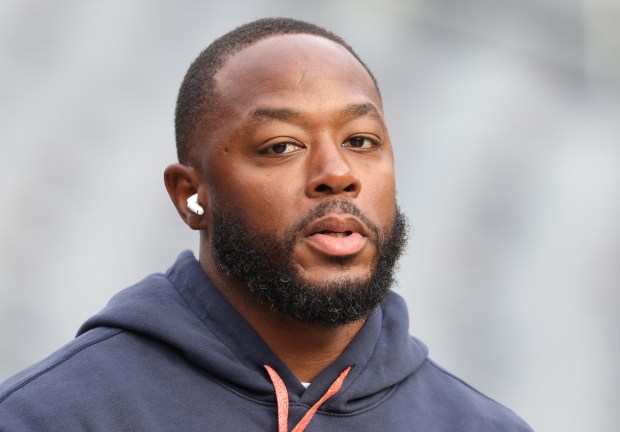
Brown is full of charisma, is direct in how he communicates and, by all accounts, has better command of the room than Shane Waldron, who was fired on Tuesday.
In the fallout and examination of where Matt Eberflus went wrong in choosing Waldron as the replacement for Luke Getsy, there are a lot of directions you can go. Waldron was one of nine candidates the Bears interviewed for the job. From that respect, it wasn’t a hasty and rushed process. Eberflus and GM Ryan Poles flew all over the country meeting with candidates.
Waldron was the only option invited for a second interview, for which he came to Halas Hall before being hired. The fact that Waldron is also a client of powerful agent Trace Armstrong, the former Bears defensive end, is one factor worth examining. The Bears have a history of having the head coach and offensive coordinator represented by the same agent.
What’s perhaps more glaring in how the Bears built a new offensive staff (line coach and run game coordinator Chris Morgan and tight ends coach Jim Dray were the only assistants retained from 2023) is that they didn’t add any coaches with proven experience developing rookie quarterbacks.
“Shane was never a quarterback guru,” one offensive coordinator for another team said. “All of a sudden you have a guy who never played the position or really coached it for very long in charge of developing the No. 1 pick. That was what was bizarre to me going back to January.
“Everyone says Kliff Kingsbury and why didn’t the Bears hire him? I don’t think he was going to go there. He was out doing that analyst thing for a season at USC. Yeah, he was there with Caleb Williams but he was looking to get on the front end of something (with a new coaching staff) and not the back end of something with a coach under pressure to win. Why go to Chicago? I would imagine Eberflus knew that too and figured ‘Kliff isn’t going to take that so I’ll try Shane.’
“So, you had Shane, Thomas Brown, who didn’t play the position, and Kerry Joseph, who has barely been in the league. Shane is a guy who has a hard time delegating. Easy to say now but no wonder it didn’t work.”
Waldron, 45, was a tight end and long snapper at Tufts and in the NFL was a quality control assistant, tight ends coach, passing game coordinator and had the dual role of passing game coordinator and quarterbacks coach in 2019 for the Los Angeles Rams. Pete Carroll made Waldron the offensive coordinator of the Seattle Seahawks in 2021.
Can Thomas Brown’s fresh approach help unlock Chicago Bears rookie QB Caleb Williams?
There are plenty of examples of coordinators who have had huge success as play callers without experience playing quarterback so that’s not a red flag by itself. But the Bears didn’t form a staff of coaches with resumes of really developing young quarterbacks.
They did build a large staff of offensive assistants and you have to wonder how the dynamics worked in the quarterback room with Eberflus having a voice, Waldron overseeing it and then Brown, Joseph, Ryan Griffin (offensive assistant/quarterbacks and receivers) and Robbie Picazo (offensive assistant/quarterbacks and receivers). That’s six coaches with a title that would at least lead you to believe they’ve got some role in working with Williams and/or the passing offense. That doesn’t include wide receivers coach Chris Beatty.
“Who’s talking and who do you listen to?” the offensive coordinator said. “You know how hard it is to make sure all six guys or seven guys, whatever, are on the same page with everything? If everyone is on the same page, then you let the quarterbacks coach work with the kid. But that’s a huge kitchen to have that many cooks in there.”
It’s all stuff the Bears will have to work through after the end of the season to determine what direction they want to go offensively and in terms of developing Williams in 2025. For now, they need to make sure Williams is receiving a clear message and the direction is unmistakable. All indications are Brown has control of the situation and will be a more direct communicator but it’s a difficult spot for everyone to be in.
7. When Ryan Bates expresses gratitude for the way GM Ryan Poles handled his shoulder injury it’s because, without a solution, the veteran offensive lineman probably would have been forced to retire.
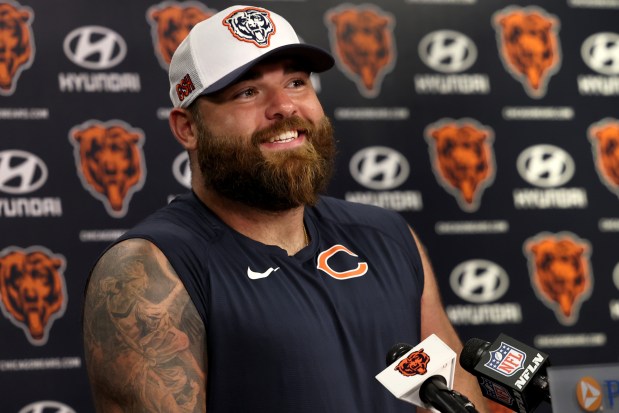
The Bears placed Bates, 27, on injured reserve after Week 1 with a left shoulder injury. The veteran credits a trip to Panama to receive stem cell therapy for reviving his career.
The team and Bates, who started at left guard against Green Bay in place of Teven Jenkins (ankle), hoped rest during training camp would alleviate the pain he had in his shoulder. That didn’t work and each time he returned, it was worse. Bates got a platelet-rich plasma injection in his shoulder and that, with more rest, did little to alleviate his situation.
Now, Bates will have to work his way through concussion protocol. He left the game after the first offensive series, replaced by Jake Curhan.
The important thing is that when Bates clears concussion protocol, his shoulder will be in good shape. Nothing was structurally wrong with it. He was battling arthritis that was more severe than anything he’d previously encountered in a career that, before this season, had never included a trip to injured reserve. The shoulder pain would calm down a little bit as Bates rested during training camp and preseason but each time he returned to play, the shoulder lacked strength and the pain quickly returned — worse than before.
“It was all pain management and I was in excruciating pain,” Bates said. “I couldn’t do a push-up. I couldn’t lift my arm above being parallel to the ground. I couldn’t do a whole lot because there was no movement in that joint because everything was in so much pain.”
Bates felt terrible because he knew the Bears had extended themselves for him. They signed him to an offer sheet as a restricted free agent in 2022, hoping to get him out of Buffalo. The Bills matched the contract. The Bears tried to trade for Bates last year and then acquired him in March for a fifth-round draft pick. He had gratitude for the faith the Bears had shown in him and wanted to make them feel good about the investment.
Bates huddled with the team’s trainers and doctors. He consulted with outside shoulder experts. His agent Noel LaMontagne had researched stem cell therapy and introduced it as a possibility — one Bates would have to pay for himself — and all parties mulled the options.
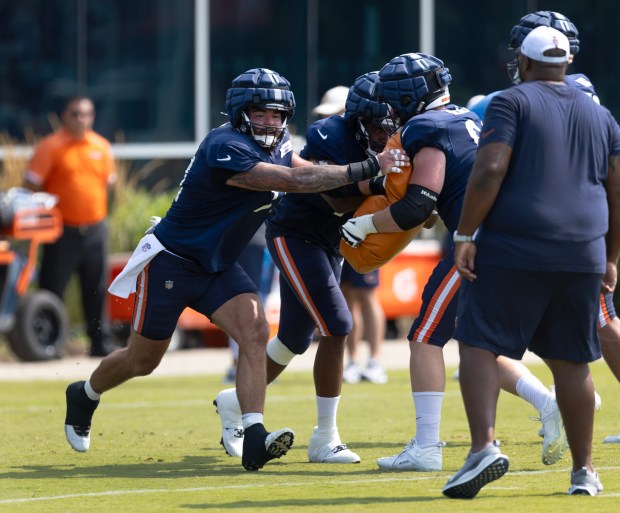
Surgery wasn’t recommended because there was nothing structurally wrong with the joint. Medical professionals explained the potentially small risks — stem cell treatment is not approved in the United States. Bates spoke with other athletes who turned to stem cell treatment, liked the positive feedback he received, and with the team’s blessing a plan was put into motion quickly, knowing each day was of the essence if he was going to be able to return to play.
About a week after he was moved to IR, Bates was in Panama City at Auragens, a company that on its website says it has worked with NFL veterans including Indianapolis defensive tackle DeForest Buckner, Philadelphia Eagles cornerback Darius Slay and Packers defensive tackle Kenny Clark, among others.
Bates’ treatment plan included five days at the facility and he said he noticed a difference within 72 hours of being finished.
“It was almost immediate relief,” Bates said. “And then within a month I am back on the field again. It’s a shame something like these procedures are not offered for us in America.”
Stem cell treatment can cost anywhere between $10,000 and $30,000 and when factoring in travel expenses, Bates was likely on the higher end of that range.
“It wasn’t cheap,” he said. “But it was an investment for myself. I’m investing in my body, my career now and for my future career. It just made sense. What I was doing wasn’t working. This was a solution and my shoulder feels 1,000 times better.
“I’ve already recommended it to multiple people, not only on this team but other teams. Honestly, I probably would have retired. I couldn’t play. Now, I feel good. I feel strong. There are some bumps and bruises in there, some scar tissue. But I feel strong. It was honestly life-changing.”
8. There’s no way to sugarcoat how disappointing it is to the franchise to continue to lose to the Packers.
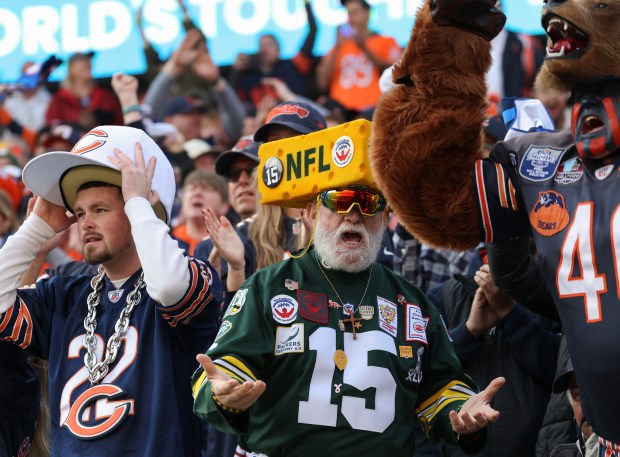
The McCaskeys get out of bed year-round thinking about beating Green Bay. The franchise, through numerous regimes, simply cannot stop what has become the NFL’s most lopsided rivalry of late.
The Packers have won 11 straight in the series, the longest streak for either team. That’s also the longest active winning streak for any team in the NFL against any opponent. The Packers won 10 consecutive games in the series between 1994 and 1998. They now hold a 107-94-6 edge in a series that — before Brett Favre arrived in Green Bay — was dominated by the Bears.
Green Bay has won 26 of the last 31 meetings at Soldier Field, including the postseason, and 14 of the last 15. In 18 consecutive games at Soldier Field, the Bears have not scored more than 28 points against the Packers.
“This is a game I’ve wanted to win for a while now,” said Cole Kmet, who labeled the loss “devastating.”
The Bears have way bigger issues than their rivalry with the Packers right now. They’ve got a ton to figure out. But to ultimately get on the path to where they want to be headed, they’ve got to find a way to turn the corner against NFC North foes, especially the Packers.
And this game was right there for the taking — they were that close to getting a badly needed victory. Instead, it was another loss that cannot sit well with chairman George McCaskey. The Bears are 3-24 against the Packers since McCaskey was elevated to his current role in 2011.
9. The first time Thomas Brown had the title of offensive coordinator, he was an assistant under Mark Richt at Miami from 2016-18, also overseeing the Hurricanes running backs.
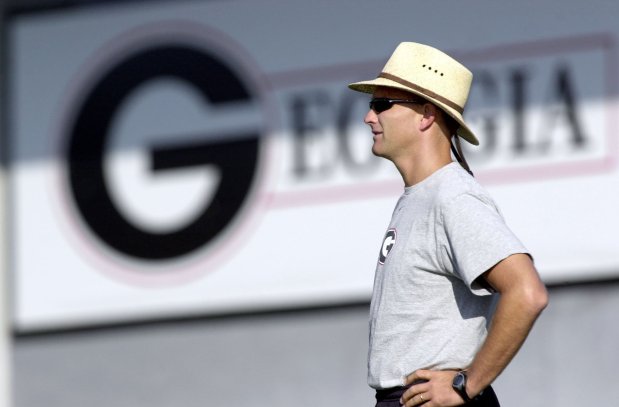
Richt recruited Brown to Georgia as a running back and had him on his staff as a strength and conditioning coach in 2011 after injuries had ended a brief NFL career. He chuckled when I suggested his former player and assistant could not be in a more challenging position taking over midseason as the coordinator for a struggling offense.
“In a sense, yes, but there’s probably only one direction you can go,” said Richt, who was the head coach at Georgia from 2001-15. “That’s kind of in his favor and any signs of success would be welcomed, I am sure. Sometimes the toughest job is to take over for a guy like Nick Saban. I think I’d rather take over a situation where they are struggling than if you are following a guy who was the ultimate success.”
That’s one way to look at it. Richt believes Brown is poised for success because of the characteristics the coach saw in him as a player and blossoming assistant.
“Thomas is a guy that really could have done anything in life he wanted, to be honest with you,” Richt said. “Very sharp guy. Very good communicator. A guy that has a presence about him. As a player he was probably pound-for-pound the most physical guy we had in the (Georgia) program. He was a physical runner, a physical pass protector and he was smart. Learning the running back position isn’t the hardest position in football to learn, obviously, but you knew he was just a very sharp guy.
“Not a shock at all how his career has advanced. It wouldn’t have surprised me if he had gone into another field or been a lawyer or a doctor or whatever. Whatever he wanted to do. Thomas is that kind of guy.”
Richt believes Brown’s straightforward approach will benefit him as he tries to bring the Bears offense together on the fly. Good communication and credibility are the first things a coordinator needs to get buy-in.
“His players respected him because he played the position he was coaching and he was young enough and strong enough to still demonstrate,” Richt said. “The older you get, the more you have to tell them. The younger you are, the more you can show them. He can still show them. I guarantee if he put the pads on and you asked him to pass-block somebody he would do a hell of a job.
“So, he had credibility with all the guys he coached because of his experience as a player and his success. Guys respected him.”
Initial indications are Bears players are tuned into what Brown is saying. The Bears put up 391 yards of offense, converted on third down and didn’t commit any turnovers. Maybe it was easier than trying to follow in the coaching steps of a Saban.
10. The Bears were 3 for 3 on fourth down and lead the NFL with 15 conversions on fourth down. They are 15 for 23 overall (65.2%).
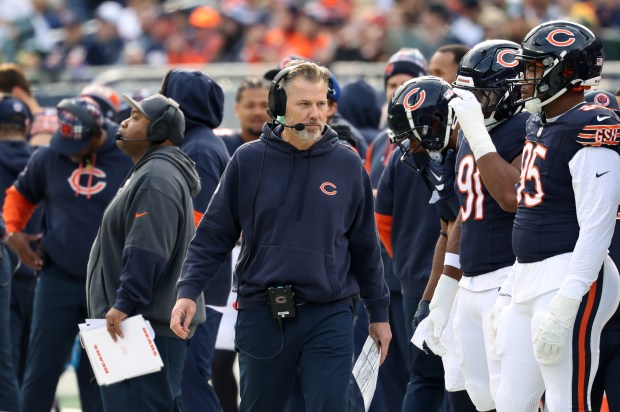
- Caleb Williams connected with Roschon Johnson for an 8-yard gain on fourth-and-2 on the opening possession of the third quarter, ultimately leading to a field goal.
- Williams ran around the left side for 4 yards on fourth-and-1 later in the third quarter before D’Andre Swift’s touchdown run.
- Then, there was the big pass to Rome Odunze on fourth-and-3 in the fourth quarter.
The franchise record for fourth-down conversions in a season is 20 in 1996 when the Bears were 20-for-28 (71.4%). They had 17 conversions on fourth down in 2020 and two other seasons with 15 conversions (2020 and 2003).
10a. Cornerbacks Tyrique Stevenson and Terell Smith continue to split time opposite Jaylon Johnson. They rotated every two series. Smith came up with an interception at the 1-yard line on a horrible pass by Jordan Love. He didn’t do anything special but as defensive backs coaches will say, “you gotta catch the ones that come to you.”
10b. Packers wide receiver Christian Watson (150 yards, four receptions) became the first opponent to reach 150 yards against the Bears since Tampa Bay’s Mike Evans had 171 in Week 2 last season. Cornerback Jaylon Johnson slipped and fell trying to cover Watson on the 60-yard gain in the fourth quarter that set up the game-winning score. The Bears had a pressure on and Johnson was locked in man coverage.
Watson is only the third receiver to average more than 37 yards per catch (37.5) with 100 yards receiving against the Bears since 2000. Detroit’s Kenny Golladay had four catches for 158 yards in a 2019 meeting and Cleveland’s Austin Hooper had two catches for 128 yards in 2017.
10c. The Fox crew of Kevin Kugler, Daryl “Moose” Johnston and Laura Okmin will call the game against the Minnesota Vikings this coming Sunday at Soldier Field.
10d. The Vikings opened as a four-point favorite over the Bears at Westgate SuperBook in Las Vegas for this Sunday’s game.



